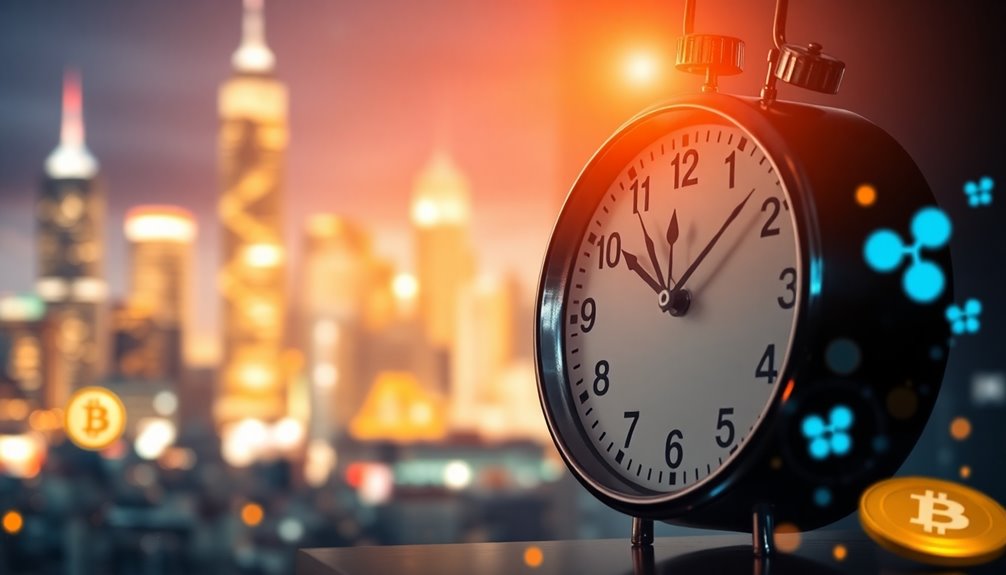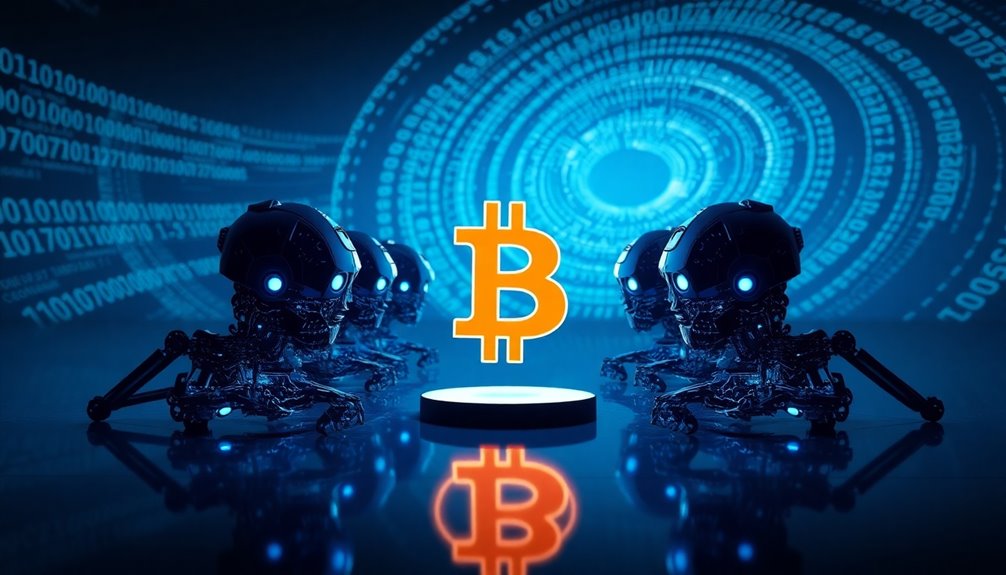Ripple is on the verge of a major regulatory shift that could completely reshape the financial world. With court rulings indicating that XRP is not a security for public sales, market confidence is likely to soar. This approval could lead to increased adoption of XRP and its new stablecoin, RLUSD, greatly improving cross-border transactions. As institutional investors grow more interested, Ripple's influence in this arena expands. You might just find that understanding the nuances of these changes will reveal how they can impact your financial interactions and the broader market.
Key Takeaways
- A favorable regulatory decision for Ripple could solidify XRP's legitimacy, attracting more users and investments in the cryptocurrency market.
- Ripple's RLUSD stablecoin integration may drastically enhance transaction efficiency, reducing costs and improving accessibility for global remittances.
- Institutional interest in XRP is rising, with potential ETF developments signaling a shift in market dynamics and increasing demand for XRP-related financial products.
- The court ruling that XRP's programmatic offerings are not securities could reshape the regulatory landscape, encouraging broader adoption and confidence in cryptocurrencies.
- Ripple's innovations could revolutionize cross-border payments, leading to increased financial inclusion and potentially transforming global monetary policies.
Overview of Ripple's Legal Battle

Ripple's legal battle with the SEC has been a pivotal moment for the cryptocurrency industry. When the SEC filed its lawsuit on December 21, 2020, it claimed that XRP was an unregistered security, sparking a fierce debate over regulatory definitions in the crypto space.
Ripple's CEO, Brad Garlinghouse, and co-founder Chris Larsen faced accusations of aiding and abetting these alleged violations, although those charges were dropped later.
The court's summary judgment revealed a mixed outcome—Ripple's programmatic XRP offerings weren't classified as securities, but institutional sales were deemed securities transactions. This ruling highlighted the complexity of financial regulations and the court's careful assessment of different transaction types. Additionally, the court has extended the discovery period until February 12, 2024, allowing for continued examination of critical documents.
Ripple's financial burden has been immense, with over $150 million spent on legal defenses, yet it continues to expand its services amid the turmoil.
Ongoing disputes regarding the SEC's document requests add another layer of tension, particularly around the claims of new violations. As Ripple navigates this challenging landscape, the implications of the court's decisions could redefine the regulatory framework for cryptocurrencies moving forward.
Regulatory Environment Shifts

The recent court ruling has considerably influenced the regulatory landscape for cryptocurrencies, prompting shifts in how various regulatory bodies approach oversight. With the court determining that XRP isn't a security when sold to the public, it's reshaping the SEC's strategies.
However, sales to institutional investors still fall under securities regulations, highlighting a nuanced regulatory framework.
As the SEC, CFTC, and DOJ ramp up enforcement, the focus remains on consumer protections, fraud prevention, and maintaining market integrity. The U.S. regulatory environment, however, is fragmented, with multiple authorities possibly having jurisdiction over cryptocurrency transactions. Notably, the recent surge in XRP's market cap exceeding $100 billion demonstrates the increasing significance of these regulatory developments.
You might find it significant to stay informed, as legislative changes could define a clearer regulatory regime.
Furthermore, new appointments, like a crypto-friendly SEC chair, could lead to a more lenient regulatory atmosphere. This optimism encourages institutional adoption, with companies eyeing XRP-based ETFs.
As you navigate this evolving landscape, understanding compliance and risk strategies becomes vital. Expect heightened supervision and enforcement as boards set clear directions, ensuring that you're prepared for the rapid changes ahead in the crypto space.
XRP Market Performance Trends

Amidst the evolving regulatory landscape, XRP has shown remarkable market performance, with its price soaring to $2.43 as of December 2, 2024. The cryptocurrency has experienced a staggering increase of nearly 300% since the start of the year, and it recently hit a 24-hour high of $2.50, the highest level since 2018.
With a market capitalization nearing $139 billion, XRP stands as the third-largest cryptocurrency.
Over the past month, XRP's value surged by 375%, fueled by strong technical indicators like increased trading volume and a bullish Relative Strength Index (RSI). This rally has pushed XRP past several key resistance levels, creating significant upward momentum.
Additionally, network activity has spiked, with 1,721 new addresses created and 47,363 users interacting at peak times. This fresh adoption is essential for sustaining price rallies. Ripple's partial legal victory has also played a crucial role in restoring investor confidence and stimulating market interest.
Looking ahead, short-term forecasts suggest XRP's price could fluctuate between $1.96 and $2.67 in December, with an average expected around $2.67.
If legislative changes align favorably, there's potential for a dramatic rise, possibly reaching $4, although caution is warranted due to possible overbought conditions.
Institutional Interest in XRP

Increasingly, major financial institutions are recognizing XRP's potential, particularly for its efficiency in cross-border payments. The recent surge in transaction volumes in Asian markets, especially Singapore and Japan, highlights this growing interest. The July court ruling, declaring XRP is not inherently a security, has further fueled institutional enthusiasm. This has led to a significant increase in XRP's market capitalization, which reached nearly $139 billion. Additionally, the decentralized nature of blockchain technology enhances the appeal of XRP for secure transactions.
Several prominent players are stepping into the space, pushing for XRP-related exchange-traded funds (ETFs). Ripple CEO Brad Garlinghouse asserts that an XRP ETF is "just inevitable," mirroring the success seen with Bitcoin ETFs. This trend signals that institutional demand is driving the push for easier investment avenues.
Here's a snapshot of the current institutional interest in XRP:
| Institution | Initiative | Focus Area |
|---|---|---|
| Bitwise | Filed application for XRP ETF | Investment accessibility |
| Grayscale | Launched XRP Trust | Fund conversion to ETF |
| Ripple | Partnerships with Latin American banks | Cross-border payments |
As institutional players prepare for potential ETF approvals, the momentum around XRP is undeniable. With increased adoption and favorable regulatory conditions, XRP stands poised for a significant leap in mainstream finance.
Impact of Stablecoin Launch

Ripple's launch of the RLUSD stablecoin is set to revolutionize cross-border payments, offering a more efficient and cost-effective solution for global transactions. By integrating RLUSD into its ecosystem, Ripple enhances transaction speed and reduces costs, essential for regions with high diaspora flows. You'll find that remittances become faster and more affordable, linking families and stimulating local economies. Additionally, the use of leverage in Forex trading can help investors capitalize on the benefits of the RLUSD stablecoin.
The RLUSD stablecoin also brings global accessibility, allowing transactions that traditional systems struggle to support. This opens markets to international investment and participation, fostering financial inclusion in areas with limited access to conventional banking. With RLUSD's integration into various DeFi protocols, the potential for broader adoption is significantly amplified.
The growing market capitalization of stablecoins, which surged by 17.55% recently, reflects this demand, with millions of addresses engaging with stablecoins.
Moreover, the RLUSD launch is expected to drive momentum for XRP adoption, strengthening Ripple's position in the cross-border payments arena. As stablecoins become a staple in the financial landscape, they not only mitigate risks associated with volatility but also contribute to local economic growth.
Ultimately, the success of RLUSD hinges on regulatory approval, setting the stage for a notable transformation in how we conduct global transactions.
Frequently Asked Questions
What Is Xrp's Primary Use Case in the Financial Sector?
XRP's primary use case in the financial sector is facilitating cross-border payments.
You can leverage XRP to enable near-instantaneous settlement of international transactions, which greatly cuts costs and time compared to traditional methods.
By utilizing the XRP ledger, banks and financial institutions improve liquidity management and reduce the need for expensive pre-funded accounts.
This integration enhances the efficiency of transactions, allowing you to settle payments within seconds while ensuring compliance with regulations.
How Does Ripple's Technology Differ From Bitcoin and Ethereum?
Isn't it ironic that while Bitcoin takes ages to process transactions, Ripple does it in mere seconds?
When you compare them, Ripple's speed and efficiency shine, handling 1,500 transactions per second versus Bitcoin's 7.
Plus, Ripple's fixed fees are laughably low compared to Bitcoin and Ethereum's fluctuating costs.
However, Ripple's permissioned ledger raises eyebrows, as it's less decentralized than its counterparts.
You've got to appreciate the trade-offs in this digital currency race!
What Are the Risks of Investing in XRP?
When you consider investing in XRP, you face several risks.
Regulatory uncertainties, particularly with the ongoing SEC lawsuit, can impact the token's future. Market volatility is significant, with price swings that could catch you off guard.
Additionally, potential institutional delistings and lack of staking rewards could hinder long-term value.
You'll need to weigh these challenges against XRP's growth potential, keeping an eye on key support levels during corrections.
How Can Individuals Buy and Store XRP Securely?
To buy and store XRP securely, start by choosing a compatible exchange that allows you to purchase it with a credit/debit card or bank transfer.
After funding your account, execute the purchase and verify the transaction.
For storage, select a secure wallet type—hardware wallets offer the best security.
Transfer your XRP to the wallet, ensuring you meet the 20 XRP reserve requirement, and keep your private keys safe for maximum protection.
What Are the Implications of Xrp's Fixed Supply for Investors?
Imagine a world where demand for XRP skyrockets.
With its fixed supply of 100 billion tokens, you've got a unique investment opportunity. As institutions hold more XRP for transactions, retail availability shrinks, potentially driving prices up.
This scarcity, combined with growing utility, creates an environment where demand could outpace supply, leading to significant price appreciation.
For you, this means that investing now might just yield impressive returns down the road.
Conclusion
As Ripple stands on the brink of a pivotal decision, you can sense the tension in the air. With regulatory clarity, you might witness a surge in market confidence, a wave of institutional support, and a revolution in digital finance. The potential for XRP to reshape the landscape is palpable, and as developments unfold, you'll feel the excitement of innovation, the promise of stability, and the hope for a future where cryptocurrencies thrive. Such a moment could mark a turning point not just for Ripple, but for the entire cryptocurrency ecosystem, as the implications of regulatory decisions ripple across the industry. The ripple stablecoin approval impact, if realized, could further solidify market integration, paving the way for frictionless cross-border payments and enhanced liquidity. This milestone would signify not only progress but also the maturing of digital assets into a trusted pillar of modern finance.











